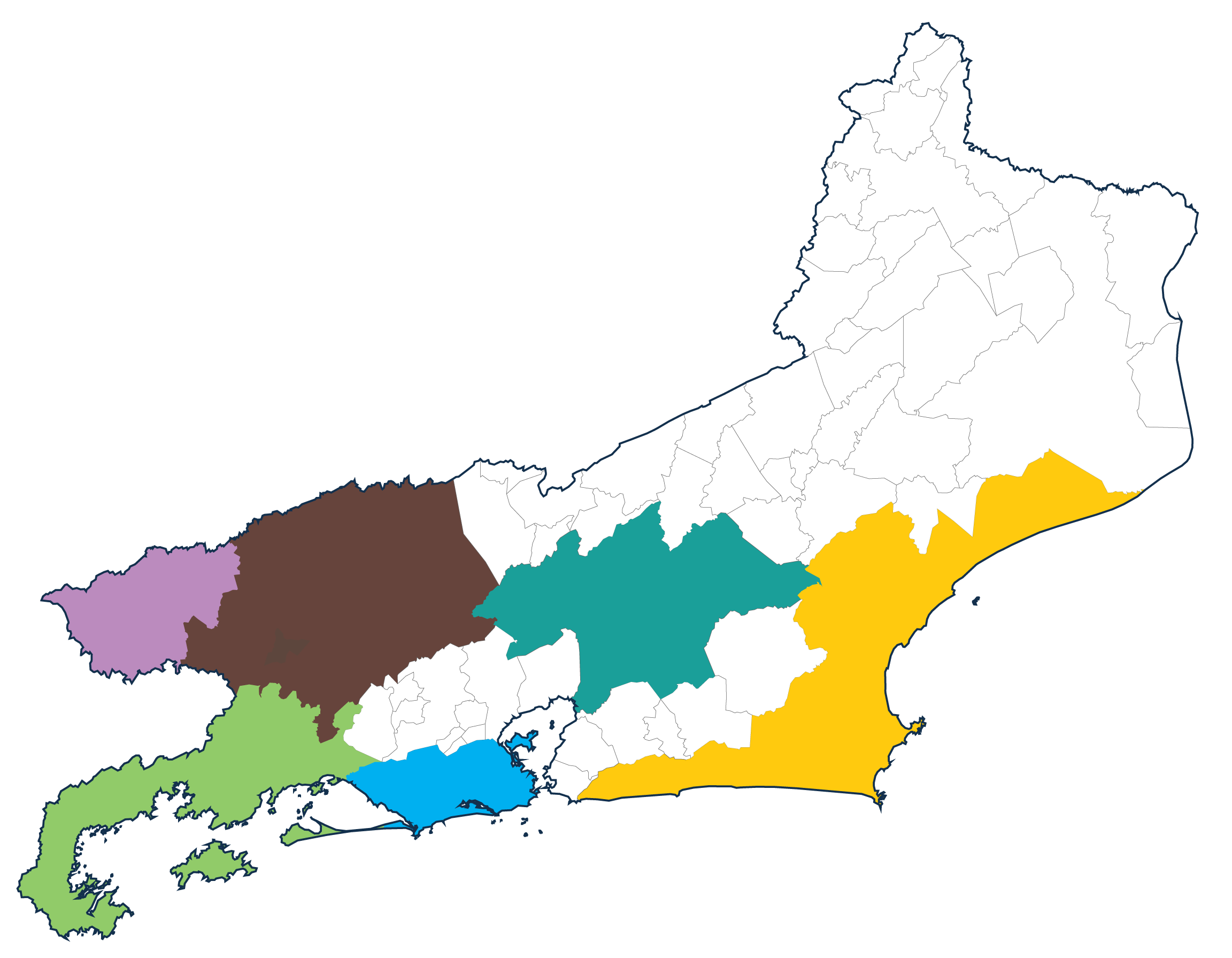A Rio of
beaches, mountains, and forests
Various parts of the state are surrounded by extraordinary landscapes, and the capital is the first city in the world to be awarded the title of World Heritage Site in the Cultural Landscape category by Unesco.
The state
in regions
Capital
The city of Rio de Janeiro has inspired singers, poets, and painters for decades, turning this beautiful geographical space into a national reference for political, artistic, and cultural events.
The sight of Guanabara Bay, surrounded by mountain ranges and hills such as Sugar Loaf Mountain, makes an impression on travelers when they cross the entrance to the bar.
With a landscape made up of beaches framed by mountains and green forests, stretching along the coastline dotted with islands, the Metropolitan Region is an extraordinary destination.
Costa do Sol
Hundreds of beautiful beaches and lagoons live up to the name Costa do Sol. The perfect route for those who love sun, sea, wind, and water sports can be found in the following municipalities: Armação dos Búzios, Cabo Frio, Arraial do Cabo, Maricá, Rio das Ostras, Macaé, Saquarema, Araruama, Iguaba Grande, Casimiro de Abreu, São Pedro da Aldeia, Quissamã and Carapebus.
Its transparent waters have earned Arraial do Cabo the title of Diving Capital. The region has all the best: quality hotels and inns, international standard restaurants, and intense nightlife, such as the well-known Rua das Pedras in the center of Búzios. To complete this scene of natural beauty, forts and churches built in the colonial period, such as the São Mateus Fort in Cabo Frio, preserve the region’s cultural scene.
Ecotourism lovers will also find their space on the Costa do Sol. There are several options in places that are not yet very well explored, such as the municipality of Casimiro de Abreu, where rafting takes place on crystal-clear rivers, which are increasingly sought after by lovers of the sport. There is room for all tribes on the Costa Sol.
Costa Verde
The Costa Verde offers some of the most beautiful and exotic scenery on the Brazilian coast, where the Serra do Mar meets the Atlantic, and the two merge in a unique way. Made up of the municipalities of Angra dos Reis, Paraty, Mangaratiba, Itaguaí, and Rio Claro, it stood out during the colonization of Brazil for the constant presence of French and English ships. As it was one of the first colonized lands in the country, it is possible to find forgotten roads and paths there, which pioneered progress towards the interior of the country. The presence of pirates, adventurers, nobles, and commoners has shaped the material and immaterial heritage of the region’s inhabitants.
Its landscape, with more than two thousand beaches and a multitude of islands, is protected by the Restinga de Marambaia and by immense walls covered by the Atlantic Forest. The waters, in various shades of green, are ideal for practicing any type of water sport.
It has many semi-deserted beaches; some, with unique shades of color, can only be accessed by sea. Ilha Grande Bay is considered the best and most beautiful part of the Brazilian coastline for sailing. In the region, you can find everything from world-class resorts and ecological paradises to historic towns like Paraty, one of Brazil’s most visited tourist destinations.
Agulhas Negras
Comprising the municipalities of Resende, Itatiaia, Quatis, and Porto Real, the Agulhas Negras region combines lush vegetation, waterfalls, and paradisiacal spots with an important set of rock formations.
A natural highlight of the region, Pico das Agulhas Negras is the highest point in the state of Rio de Janeiro, at 2,791 meters. Located in the heart of the Itatiaia National Park, the mountain range is part of a circuit much sought after by mountaineers and ecotourism enthusiasts.
For those looking for relaxation and tasty food, Penedo is the best option. The small district of Itatiaia, a Finnish settlement, has a heritage of cuisine and dance, a distinctive feature of the region.
Another place worth visiting is Visconde de Mauá. Famous for having been a retreat for hippies in the 70s, 80s, and 90s, it is a true paradise for those who enjoy waterfalls and hiking.
Vale do Café
The Vale do Café offers visitors a real walk through the history of the state of Rio de Janeiro through the following municipalities: Vassouras, Valença, Barra do Piraí, Rio das Flores, Miguel Pereira, Piraí, Paty do Alferes, Pinheiral, Mendes, Engenheiro Paulo de Frontin, Barra Mansa, Volta Redonda and Paracambi. The rural architecture of the time is imposing, as this region produced the coffee that dominated the national economy.
Perfect for those who want to enjoy the tranquility of the farms or go on ecological walks. A region where you can explore the period of the coffee cycle in a beautiful place full of preserved buildings from the time. The estates where the large mansions of the coffee barons and the slave quarters were located are a true historical and cultural heritage. The Vale do Café is a must-see for those who want to learn more about our past.
Serra Verde Imperial
The Serra Verde Imperial combines the beauty of its vegetation with the charm of its exquisite gastronomy, cultural attractions, and shopping opportunities. With a climate that invites you to the pleasures of fine dining, the region is famous for its restaurants and cozy inns.
In winter, it becomes even more special, with festivals that enliven all the towns. In summer, the rivers, waterfalls, and trails are a real invitation to ecotourism. For the more adventurous, the region is the cradle of national mountaineering and has the country’s most famous traverse, the Petrópolis-Teresópolis in the Serra dos Órgãos National Park.

See
more
